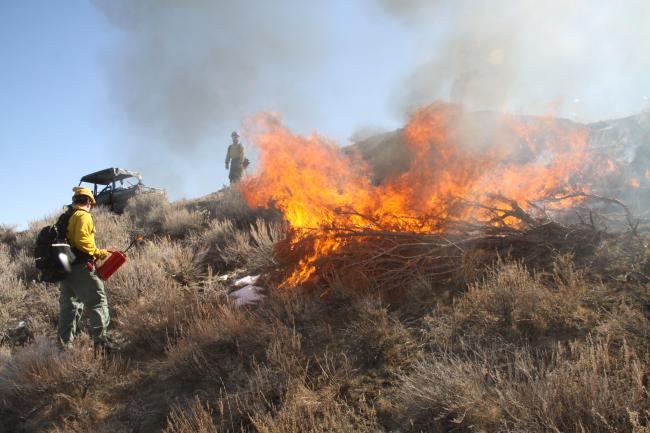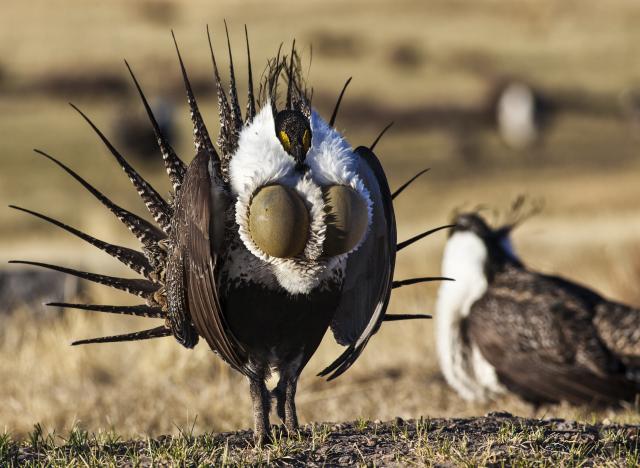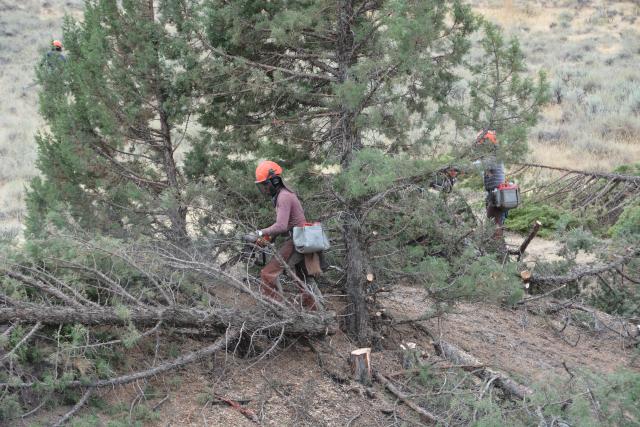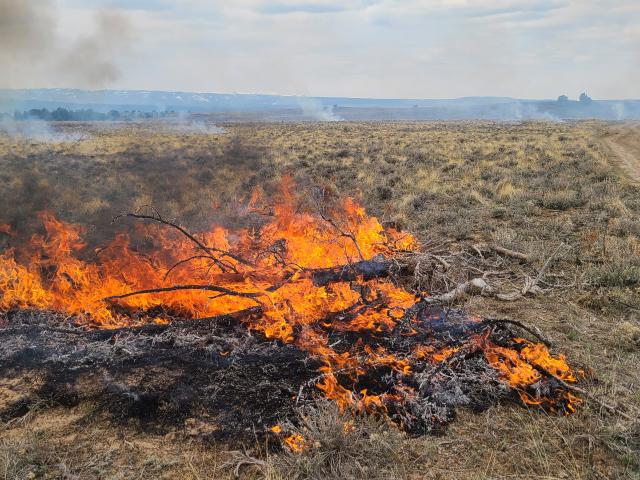In Idaho, protecting and growing sagebrush ecosystems requires an “All Hands, All Lands” approach
Listen
Subscribe
Related Content
In Southern Idaho, BLM has been working with state and federal agencies and private landowners to treat and strengthen sagebrush habitat. In the Boise District, one of the largest projects is the Bruneau-Owyhee Sage-grouse Habitat project (BOSH). One primary purpose of BOSH is to reduce the number of juniper that are crowding out sagebrush and grass ecosystems, which are critical to the health of sage-grouse and other species. Cutting juniper to give the understory shrubs and grasses a chance to grow is one critical step. Another is to conduct prescribed burns. In this episode, we interview Lance Okeson, who has been working for many years on the BOSH project.
Transcript
NARRATOR (David Howell, BLM Communications): Western Juniper, along with its closely-related cousins, is a tree that, if left on its own, will outcompete native grasses and sagebrush for dominance. It’s also a dense wood that contains highly flammable oils that make range fires burn hot and fast – something BLM classifies as “hazardous fuel.”
I’m David Howell, and you’re listening to “On The Ground: A Bureau of Land Management Podcast.” For most of the 20th Century, state and federal fire management agencies fought all fires equally: aggressively. However, removing fire from the landscape created other ecological problems, especially for wildlife species that require sagebrush to survive, like the Greater Sage-grouse.
Lance Okeson is a second-generation BLM employee, following in his father’s footsteps. In the early part of his career, Lance worked in central Oregon on large-scale projects that removed juniper from the landscape. For most of the last 20 years, Lance has worked in BLM’s Boise District in Idaho, developing the Bruneau-Owyhee Sage-grouse Habitat project, or BOSH, a program for managing hazardous fuels to protect sagebrush and sage-grouse habitat. These high-desert birds are at risk of being put on the U.S. Fish & Wildlife Service’s endangered species list and are often a key indicator species for whether the land is in good shape.
Two drivers for treating sagebrush habitat
LANCE OKESON (Supervisory Fire Management Specialist, BLM Idaho): I came to Boise and it was like, literally, going 20 years back in time and having to convince people that it's the right thing to do, to reintroduce fire in a fire landscape, and that these juniper everywhere isn't normal. The only reason it's that way is because we've taken fire out of these ecosystems. And of course, this [large wildfires] is a natural result. It was amazing.
But anyways, we started working on that stuff. And then, of course, the sage-grouse issue, the potential listing, and looking into that from the Fish and Wildlife Service, and then them coming up with, “Hey, what are the main threats to the sage-grouse populations?” -- one of them being conifer encroachment; the other being, you know, the annual cheatgrass or annual conversion after these huge wildfires.
HOWELL: Right.
OKESON: Those are the ones that we can work on, right? And that is: How do we manage these fires? How do we get them to be back toward their normal return interval and kind of more of a normal size, right? For me, it's unacceptable to have a 500,000-acre fire. For me. This is on a personal level and it terrifies me to see the fire community start to normalize 500,000 acre fires! And I'm just like, “wait a minute, this is unacceptable!” We should still be back to a 5,000- [or] 10,000-acre fire as something to be talked about, not a 500,000 acre [fire]. We should never even be having these. Because we should be managing our fuels properly. And so, that's been my approach on that. So that’s that fire part of the threat.
Juniper encroachment phases, and getting back to a normal fire interval
NARRATOR (Howell): Lance and I then got into a conversation about the three phases of juniper encroachment. This was developed by researchers at Oregon State University, but basically, here’s how it lays out. In Phase 1, you have juniper trees scattered “here and there” on the landscape, not really dominating. There’s more sagebrush and grass than trees at this stage.
In Phase 2, you have equal amounts of sagebrush and juniper, enough that you still also have an understory of shrubs and grasses growing under the trees.
OKESON: But another 20-30 years of that, it goes into Phase 3 to where it starts to dominate the whole system. Now it's out-competing; the first thing it does is it outcompetes the brush -- the brush starts to die out in the inter-spaces. If you let it go far enough, and if it's on shallower soils, it'll actually outcompete the grass, and then you just got dirt and trees. That's the end of the cycle, right? And normally you would have a fire intervene in between those cycles and always be knocking it back to an early-seral sagebrush steppe, that kind of thing. Well, we took fire out of the system. So everything's just going right to Phase 3.
NARRATOR (HOWELL): Lance explained that the Bruneau-Owyhee Sage-grouse Habitat Project, BOSH for short, removes dense, Phase 3 juniper through two treatment methods. One is cutting the trees down to the ground so that the rest of the plants, the sagebrush and grasses, have a chance to come back. But cutting trees creates slash piles – basically, all the trunks and branches – that then dry out and need to be burned. That brings us to the other treatment method: prescribed fire.
OKESON: It's great what we're doing, but basically we're trying to cut our way out of a situation that was created by taking fire out of the ecosystem and we need to introduce fire to the ecosystem and get it back at a landscape level. And that's really the long-term future. It's not just cutting and cutting and cutting and cutting, and it pops up, you go back and cut it pops up, go back and cut it... That's not, you're not working with the system. The system is that fire needs to come periodically, and we're doing that to a certain scale on the District, also. We're doing a lot of landscape burning also.
But that has to be part of that long term strategy. I keep telling these guys you can't cut your way out of this problem. You've got to start using fire. Because the return interval for fire is, you know -- it could be 60 to 80 years! Well, the return interval for this cut -- we go in and cut it, you're 10, 15 years and it's got juniper all over it again. They're smaller, but now we got to go cut it again! And then 10, 15 years, you got to cut it again! Well, how many cycles? And again, if you use fire, now you're back out to that 60, 80 year return interval. It's the natural thing. It's the way it was supposed to be!
About Partners
NARRATOR (Howell): The BOSH Project encompasses more than a million and a half acres. The treatment area is about 600,000 acres, or about one-third of the total acreage, scheduled over a ten-year cycle. Not all of that land is managed by the BLM.
HOWELL: What's been the reaction of the ranchers that are out there as you started planning on BLM-managed lands, we're pulling in the state, and some of the ranchers come along with funds from the Natural Resources Conservation Service. How have they responded to this kind of an approach?
OKESON: I would say that it's been really positive. Because again, this bunch down here in the Owyhees is a good bunch to work with. And really, the whole thing is being just upfront and honest on everything and just… The only, I guess, consternation is that is where we have a conversation now and it's like, “Okay, yeah, your land needs to be treated. But let's treat it in five years instead of this year, because if you wait five years, then we're going to be doing the BLM all the way around you and we can work together on getting the slash cleaned up with the fire.”
And I just I think it's going to get better every year, because there's always those people that are like, “I've always wanted to do this, but I was afraid to do it.” And if we can work together, we can all succeed.
So if you work with those people first, you show success that goes through the community and people start to realize that, “Hey, this is legit.” And so then, you build that trust and you can really start to, you can really start to do some cool things.
NARRATOR (HOWELL): Lance Okeson is a Supervisory Fire Management Specialist in BLM’s Boise District in Idaho. The BOSH project is part of the Snake River Plain Restoration Landscape area, funded, in part, by the Inflation Reduction Act.
We have more about this project on our website, which you can find at BLM.gov/media/podcasts. From there you can find all of our “On The Ground” episodes, and you can also find a link to “Wildfire Matters,” another podcast produced by our colleagues at the National Interagency Fire Center in Boise.
By the way, if you’re heading to public lands, make sure you check the rules about campfires, and see if they are allowed in your area. I’m David Howell, and we’ll see you out there, “On The Ground.”





